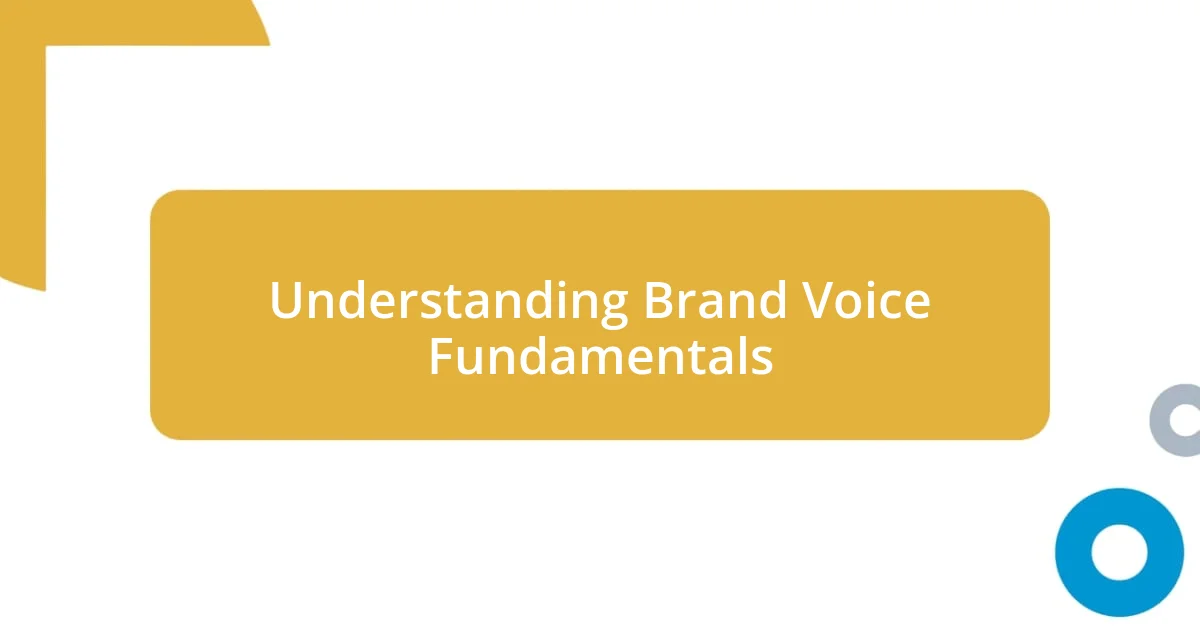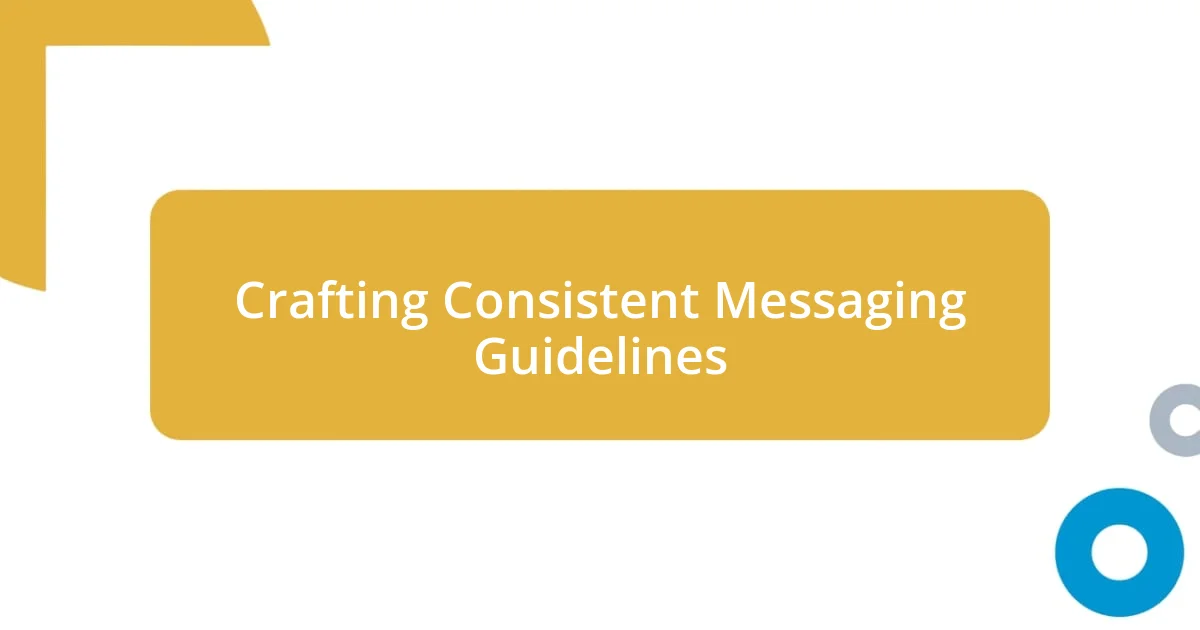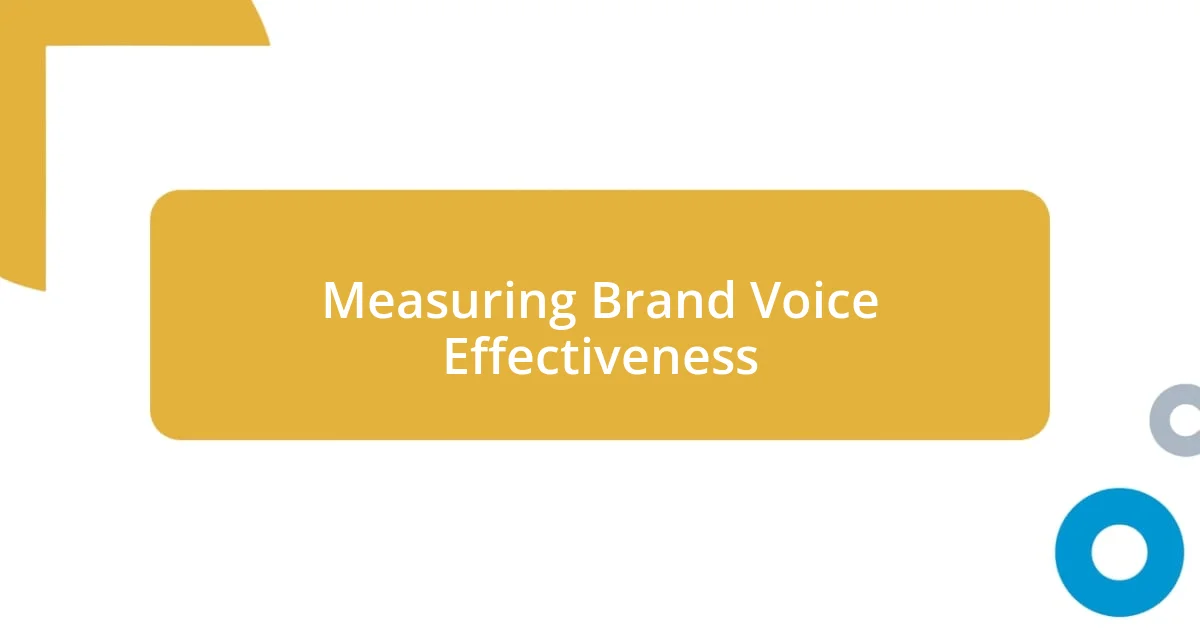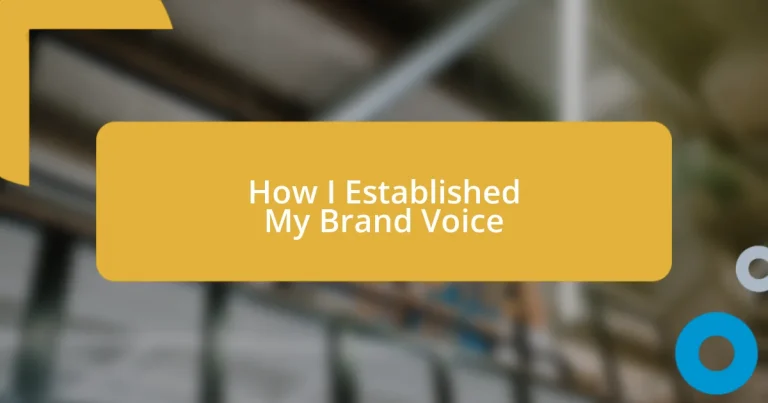Key takeaways:
- Effective brand voice relies on authenticity, consistency, and understanding the audience’s needs and emotions.
- Analyzing competitors’ brand voices helps identify unique elements that can be adapted to enhance one’s own brand identity.
- Measuring brand voice effectiveness through engagement metrics and feedback is crucial for continuous improvement and connection with the audience.

Understanding Brand Voice Fundamentals
When I first began shaping my brand voice, I was surprised by how deeply it resonated with my audience. I realized that brand voice goes beyond just the words we choose; it’s about embodying the personality and values of our brand. Have you ever noticed how certain brands feel like they’re speaking directly to you? That connection is no accident.
One of my pivotal moments came when I received feedback from a loyal customer. They shared how my messaging made them feel understood and valued. It struck me that effective brand voice is like having a conversation with a friend—authentic, relatable, and true to oneself. I learned that my voice needed to be consistent across all platforms to maintain that connection.
Understanding brand voice also means recognizing its foundational aspects: tone, language, and style. Each element tells a different part of your brand story. For instance, I experimented with a more conversational tone in my posts and saw an increase in engagement. It was as if I had discovered a secret key to unlocking my brand’s potential. How have you explored your own brand voice?

Identifying Your Target Audience
Identifying my target audience was an eye-opening experience. It wasn’t just about demographics but understanding their interests and needs. I remember hosting a small focus group where we discussed what drives my audience. Listening to their stories gave me a deeper connection to their motivations.
In another instance, I often found myself analyzing social media interactions. I noticed certain posts resonated more with specific groups, showcasing the importance of tailoring messages. This discovery helped me refine my voice to align more closely with their expectations, making my content feel more relevant and engaging.
I also learned the significance of empathy in this process. By stepping into my audience’s shoes, I could see their pain points and joys. This human connection allowed me to craft messages that addressed their needs directly, fostering a sense of community and loyalty around my brand.
| Aspect | My Insights |
|---|---|
| Demographics | Understanding age, gender, location helps, but it’s just the starting point. |
| Interests | Connecting on shared passions creates a more personal brand relationship. |
| Emotional Needs | Empathy makes the communication deeper and more authentic. |

Analyzing Competitors’ Brand Voices
When I dove into analyzing my competitors’ brand voices, I focused on how they connected with their audiences. I looked at their tone and language, noting whether they adopted a friendly, formal, or cheeky approach. One memorable instance was when I studied a competitor’s social media strategy. Their playful banter and relatable humor were a hit with their followers, making me realize how a distinct voice can create a loyal community.
It’s essential to break down a few elements to understand what sets these brands apart:
- Tone: Is it casual, authoritative, or somewhere in between?
- Language: Are they using industry jargon, simple words, or something else entirely?
- Content Themes: What topics do they frequently cover? Is there a consistent message they convey?
- Engagement Style: How do they interact with their followers? Is it conversational or more transactional?
- Visual Elements: Do their graphics align with their voice? Visuals often enhance written content.
By dissecting these aspects, I was able to refine my own brand voice and identify what felt authentic and engaging to my audience. Each finding shaped how I crafted my messaging, ensuring it resonated deeper than a surface-level connection.

Developing Your Unique Brand Personality
Developing a unique brand personality is like discovering your voice in a crowded room. I remember sitting down with a cup of coffee, sketching out the traits I wanted my brand to embody. My personality map included values like authenticity, creativity, and approachability. This exercise made me realize that my brand isn’t just a business; it’s a reflection of who I am and what I stand for.
As I began to experiment with my communication style, I noticed how certain phrases sparked joy or laughter among my audience. For example, when I lightened the tone in my newsletters, I received heartfelt responses that thanked me for bringing a smile to their day. Have you ever had that moment when you felt a connection with a brand? That’s what I aimed to create – a voice that felt like a friend rather than a faceless corporation.
To bring this personality to life, I also focused on storytelling. Every brand has a story; it’s about how you choose to tell it. Sharing personal experiences—like my initial struggles or breakthroughs—humanized my brand and made it relatable. Those moments of vulnerability built a bridge between me and my audience, forging trust and loyalty. This approach taught me that a unique brand personality isn’t just about what you say; it’s about how you make others feel.

Crafting Consistent Messaging Guidelines
When I sat down to craft my messaging guidelines, I realized that clarity and consistency were paramount. I started by writing out a mission statement that encapsulated my brand’s core values. This wasn’t just a formality; it helped me steer every piece of content toward a shared goal, ensuring that whether I was tweeting or drafting a blog post, the message remained cohesive and aligned with who I am.
One particularly eye-opening moment came when I sought feedback on my messaging. I shared a draft with a trusted friend and was blown away by their response. They pointed out phrases that seemed more like filler than authentic reflection of my brand. It was a lightbulb moment—stripped-down wording resonates much more than embellishments. Now, I actively ask myself, “Does this really represent my voice?” before finalizing anything.
As I built these guidelines, I also made room for flexibility. Sticking too rigidly to a set style can stifle creativity. For instance, during a recent campaign, I decided to play with humor in my messaging. I received incredible engagement, which reminded me how evolving my tone doesn’t mean losing my essence. Have you ever found your voice changing unexpectedly? Embracing that adaptability has made my brand feel more vibrant and alive.

Measuring Brand Voice Effectiveness
Evaluating the effectiveness of my brand voice often meant taking a step back and observing how my audience engaged with my content. One of those moments that hit home was when I reviewed comments on a social media post I had shared. The way my followers responded not only told me they felt connected, but their language reflected the tone I aimed for. Have you ever received unexpected feedback that made you rethink your approach? It’s those little revelations that remind me how crucial it is to listen actively.
I also used analytics as a guiding light in this journey. Monitoring metrics—like engagement rates and shares—gave me tangible evidence of my brand voice’s reach. I remember analyzing the performance of a recent blog post, which included a personal story. The post outperformed others by a significant margin, and it dawned on me: authenticity resonates. Does your content reflect personal touchpoints? When it does, you often see a measurable impact.
Feedback surveys became another essential tool for gauging brand voice effectiveness. I was hesitant at first, but reaching out to my audience for their insights was a game-changer. After gaining feedback, I made subtle adjustments to my tone based on their responses. Their words revealed a depth of understanding that I hadn’t anticipated. Have you thought about what your audience feels when they read your content? Knowing this not only enhances my strategy but strengthens the bond we share.














